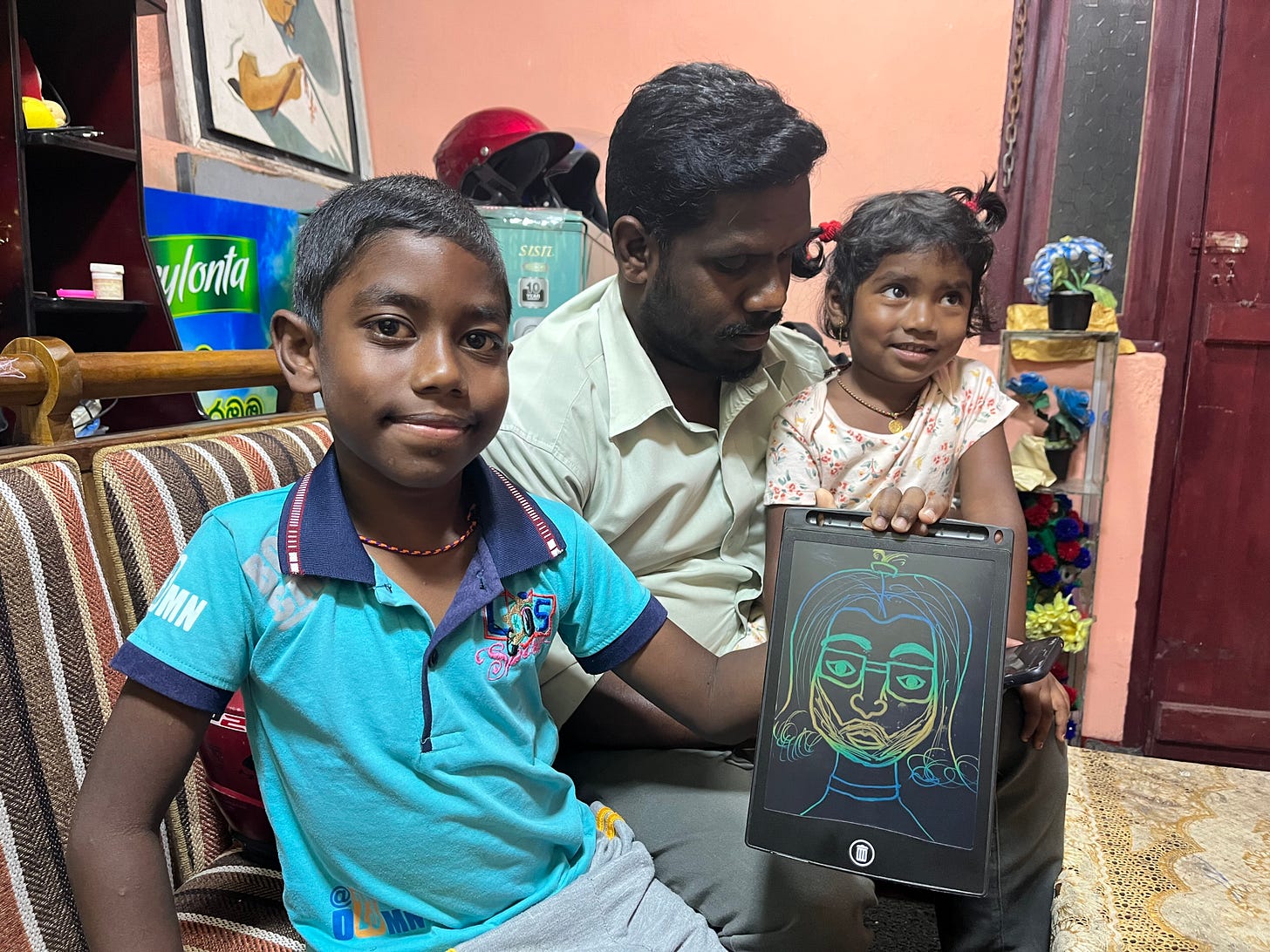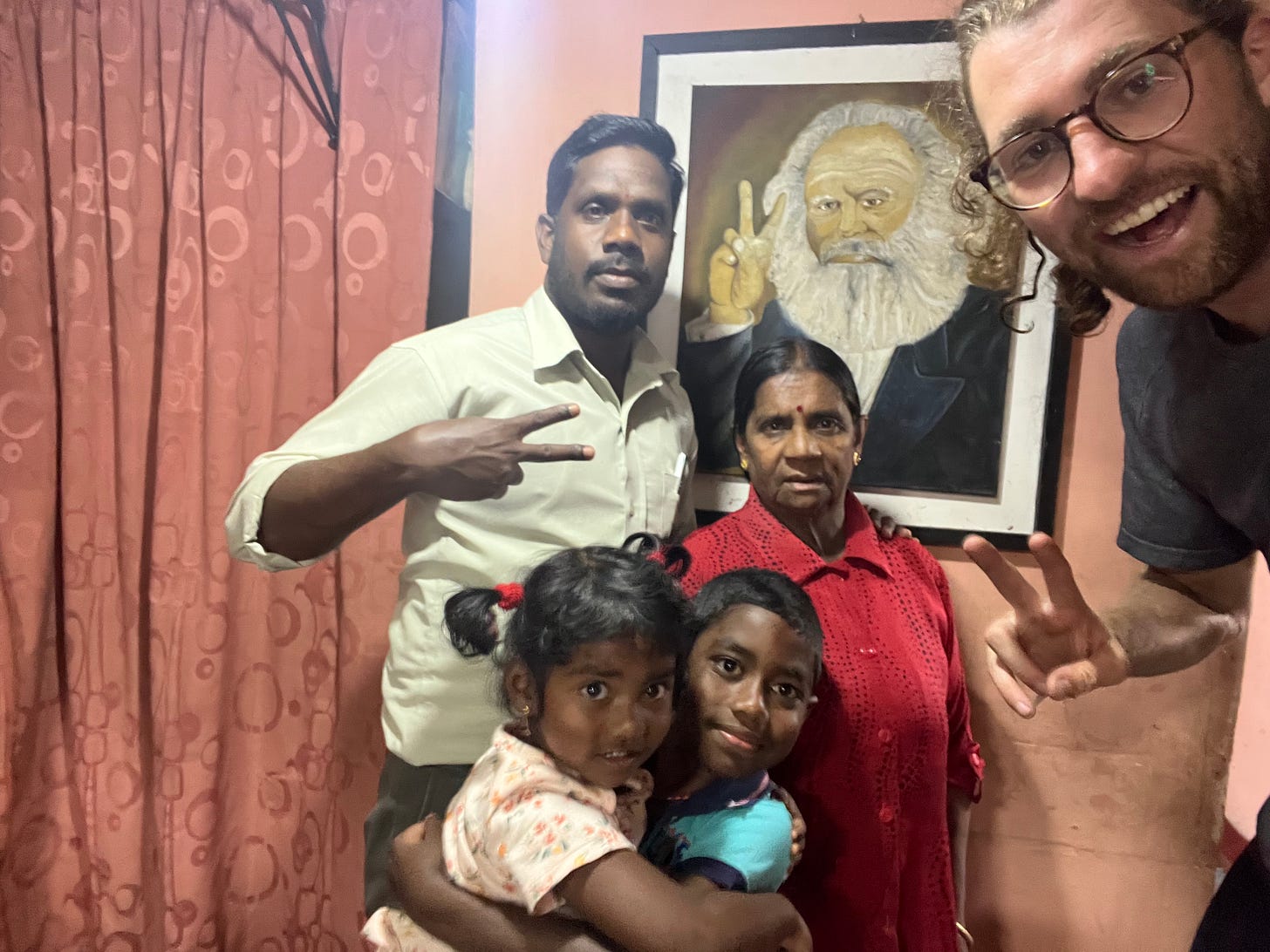176 | How creativity won’t change
Matale, Sri Lanka
I met Ram when cycling towards Nuwara Eliya. The road was steep, Ram drove alongside me on his moped and invited me for tea. We pulled open a garage door and walked into a pink-walled sitting room crowded with two gold armchairs and a gold sofa. On the mantelpiece stood a picture of his wife receiving an award for teaching, his teaching certificate, and a picture of a school with 750 students neatly smiling. Ram lives with his wife, two kids, and mother in their small home.
Ram’s wife brought us sweet tea from the upstairs kitchen. We sat talking in half sentences: Ram’s 36, an art teacher of 52 children. His wife teaches a small class of 15 at a primary school.
While we talked, his son’s gaze became more severe and investigative. I could feel his cool stare creep over me. Had I done something wrong? He searched my face for details and shadows, following the line of my neck, scrutinising the sun cream on the inside of my glasses. Then I realised he’s subtly drawing me, and he’s created a brilliant likeness. It’s not quite photo-realistic, but there’s no doubt who he’s drawn.
I asked to see Ram’s art — to his delight. I walked up the steep staircase beside a painting of a woman on a chez long, dressed like a mountain queen. It could be anyone, I thought, but I took a risk and said, “This must be your wife. Beautiful.”
Ram was thrilled that I guessed correctly: With this they smiled, I smiled, and we shared a lot of expressive eye contact.
We walked into the bedroom (I think there was only one) — the walls were a deep pink, giving a gloomed romantic feel. One small window lit the room at the far end. And here was the masterpiece.
Hanging on the wall was a picture of someone like Einstein, but not Einstein. Maybe Einstein’s cousin? The man’s beard spread evenly around his chin and head, like a halo. The man presented peace fingers. We stepped back and admired the art hanging there.
“Do you recognise?” Ram asked.
I was silent. I had no idea; it was not of his wife, I was sure.
“Karl Marx,” he said, “I like communism.”
Then we took selfies. Did Marx ever do peace fingers? When publishing Das Kapital? Or was it the artist’s interpretation? Nevertheless, it suits him.
*
This meeting was a joy and got me thinking. Ram and his son are artists. Ram is an art teacher and is very good, his son is a student and is aspiring and shows promise. How do we go from aspiring to good to, eventually, great?
Traditionally, there’s been widespread consensus that we should ‘do the reps’. We should draw more, paint more, write more. If we pump out art, we will become great. The ten thousand-hour rule says that if we practice for so many hours, we become industry-leading.
This was the consensus. But then AI comes along and does the creative work in a second that takes us hours. In the zeitgeist, people like David Perell and Tim Ferris — both brilliant — point out that we can’t compete with AI on quantity.
We thought painting a picture, designing a poster, or writing a book was impressive. But now we have machines — chatbots — which are simultaneously intelligent and dumb and biased but, once prompted, more creatively prolific than any of us.
So the revised theory is as follows: Because we can’t compete on quantity, we must compete on quality. We should create masterpieces that AI can’t create, and we should focus on quality.
In three ways, this new theory is correct:
A focus on quality teaches us we are capable of exceptional art. This raised our standards. Even the most novice writers should believe they have a Lamott or Orwell or Huxley inside them. If everyone knows they can be great (which they can), they will produce better work on average.
Only by producing quality will we float above the rising tide of content; we’ll remain on the surface, a creative survivor in the face of a tidal wave of SEO-tailored generative-AI content that’s washing away the rest of the internet.
We have ‘lived’ experience which AI does not. We can use it to colour our art. We have felt love, heartbreak, and grief — even smell and taste — and should use these liberally.
*
However, I don’t believe there is a way to get to quality without quantity. There is no substitute. We dream of magically being brilliant, but creative skills take time to develop. We can’t ask a beginner pianist to play Beethoven’s Hammerklavier instantly (a famously difficult concerto) — we must begin with Chopsticks. Every artist walks the long and tumultuous and frighteningly uneventful path of writing a lot, painting a lot, and releasing a lot of music, and that path begins as a novice.
Writing, for example, is a process of discovery and, like any intimate relationship, it can’t be rushed:
We discover excellence within ourselves by experimenting with different ideas, editing, and being consistently bad before we become good. Of course, publishing one slapping essay might be fantastic, but what about the second? Where does that come from? Doing ‘the reps’ means we build various creative skills.
These skills are contain within them further self-discovery, such as turning up to the keyboard daily, editing, tearing up draft after draft, and being comfortable with being slower and worse than we hoped (lazier, too). We learn to read like a writer, to look at landscapes like a painter. For example, I will soon review my first draft and edit the second and third drafts of this blog; I will let the idea bounce around for a couple of days. If I had not gone through the process a thousand times before, I would be stuck and unsure where to go or how to end. These subtle skills are learned through error and with practice.
The good news for us all, is that AI has not changed the creative journey: It will still take hard work if we want to be great. I suppose this is simultaneously lousy news — there are no shortcuts; we must develop taste, and ten thousand hours remains a long time. Art will continue to satisfy, because it is challenging, and reward, because, like an intimate relationship or a long cycle ride, we can’t rush it.
Live well,
Hector



